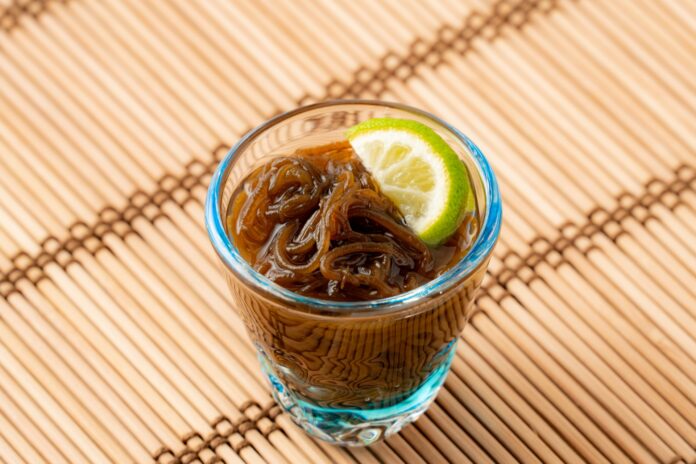Mozuku: Okinawa’s Seaweed Superfood
When thinking of Okinawa’s cuisine, most people imagine tropical fruits, pork dishes, or famous longevity foods that contribute to the region’s exceptional life expectancy. But tucked among these treasures is a lesser-known gem from the sea—mozuku, a unique type of seaweed that has become both a culinary staple and a nutritional powerhouse in Okinawan households.
What is Mozuku?
Mozuku (モズク) is a type of edible seaweed that grows in shallow coastal waters, and Okinawa accounts for more than 90% of Japan’s mozuku production. Unlike other seaweeds such as nori or wakame, mozuku has a distinctive slippery, stringy texture and a mild, slightly salty flavor that absorbs other seasonings beautifully.
This seaweed is not just harvested from the wild—it is cultivated in the clear, warm waters around Okinawa’s islands, particularly in areas such as Nanjo City and Itoman. Farmers grow it on underwater nets, making it a sustainable and eco-friendly industry that contributes to the local economy and marine conservation efforts.
Nutritional Benefits of Mozuku
Mozuku isn’t just a local specialty—it’s a superfood.
The secret lies in a natural compound called fucoidan, a type of sulfated polysaccharide found in brown seaweeds. Fucoidan is believed to have anti-inflammatory, anti-viral, and anti-cancer properties. Some studies even suggest it can boost the immune system and lower cholesterol levels.
In addition to fucoidan, mozuku is:
- Low calories
- High in dietary fiber
- A good source of iodine, which supports thyroid health
- Rich in minerals like calcium, magnesium, and iron
- A potential aid for digestive health and weight management
It’s no surprise that mozuku is a regular item on the menu for many centenarians in Okinawa.
How Do Okinawans Eat Mozuku?
The most common way to enjoy mozuku is mozuku-su (もずく酢)—mozuku served in a tangy sweet vinegar sauce. This dish is often eaten as a side dish or appetizer, and its refreshing taste makes it perfect for hot summer days. It’s simple, healthy, and a great introduction for first-time eaters.
Other popular preparations include:
- Mozuku Tempura: Lightly battered and deep-fried, giving a crispy outside while maintaining its silky interior.
- Mozuku Soup: A light, clear broth often made with bonito stock, tofu, and sometimes egg, highlighting the subtle flavors of the seaweed.
For the Less Adventurous: Mozuku for People Who Don’t Like Seafood
Let’s be honest—not everyone loves the taste or texture of seaweed. Some foreigners and even Japanese locals find mozuku’s slimy feel unusual.
To address this, Okinawan food makers have created various mozuku-based products that are easier to enjoy:
- Mozuku Noodles: Used in cold noodle dishes or soups, these have a neutral taste and pleasant bite.
- Mozuku Powder: Added to smoothies, soups, or even bread for a health boost without changing the flavor significantly.
- Mozuku Snacks: Dried or baked into crackers and chips for convenient, shelf-stable treats.
These options are great for people who want to try the health benefits of mozuku without diving into traditional preparations.
Fusion Cuisine: Mozuku Peperoncino
One of the most exciting developments in mozuku’s culinary evolution is its appearance in Western-style dishes. One standout? Mozuku Peperoncino! This is a Japanese-Italian fusion pasta dish where cooked mozuku is added to a garlic, olive oil, and chili pepper base. The result is a savory, umami-packed meal that combines the slick texture of mozuku with the familiar bite of spaghetti. It’s light, flavorful, and surprisingly addictive.
Some local restaurants in Okinawa now feature mozuku peperoncino as a signature dish, making it a delicious gateway for foreigners to experience mozuku in a non-traditional setting.
Where to Try and Buy Mozuku
You can find mozuku in most Okinawan restaurants, especially izakayas and traditional eateries. Supermarkets and local markets often sell it fresh, pickled, or frozen. For visitors, Makishi Public Market in Naha is a great place to try samples and pick up processed versions to take home.
If you’re living in Japan, even mainland supermarkets like Aeon or Don Quijote often stock Okinawan mozuku in their refrigerated sections. And for those abroad, online stores occasionally offer dried or vacuum-packed mozuku products with international shipping.
Final Thoughts
Mozuku may not be love at first bite for everyone—but its health benefits, culinary versatility, and deep roots in Okinawan culture make it a fascinating food worth exploring. Whether you enjoy it traditionally in vinegar, hidden in noodles, or spiced up in a peperoncino pasta, this slippery seaweed has something to offer for every palate.
So the next time you’re in Okinawa—or even browsing a Japanese grocery store—don’t walk past the mozuku. Give it a try. Your body might thank you for it.



